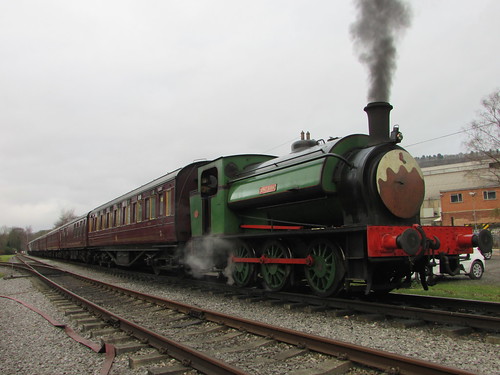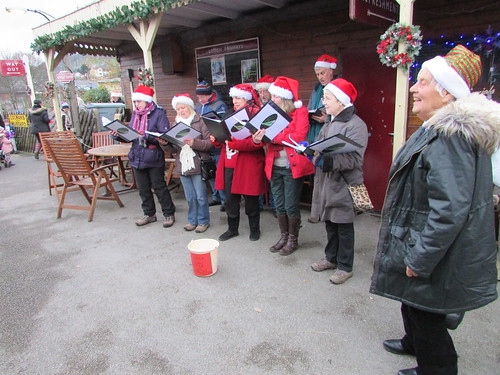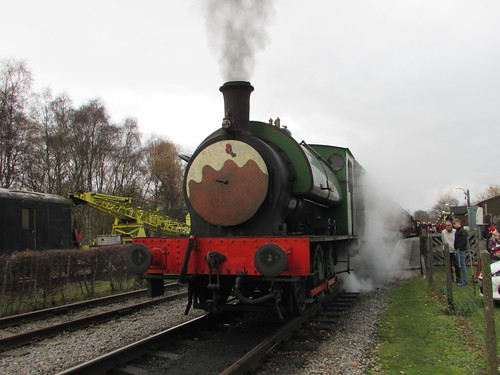The first section of CTRL (extending from Southfleet Junction to the Channel Tunnel) had opened in 2003 but trains to and from London had to use conventional lines to complete their journey. In 2006, I'd travelled over that first section of CTRL on a test train from Waterloo International to Paris (Nord), as described here.
In 2007 CTRL was completed between Southfleet Junction, Stratford International and St. Pancras International and Eurostar services transferred from the short-lived Waterloo International to St. Pancras International. At that time, Hitachi were building the Class 395 trainsets for use on CTRL and there's a short post Class 395 Trainsets. Late in 2007, I visited Ashford in connection with systems testing on the first of the Class 395 trainsets and that night-time visit is described here. Although we took the test train from Ashford to Dollands Moor to carry out tests, we used the conventional lines, not CTRL.
After the Class 395 went into service, it wasn't until February 2017 that I managed a trip from St. Pancras International to Ebbsfleet International and back - that's described in the post here.
So, having travelled on CTRL in 2007 from Southfleet Junction to the Channel Tunnel (and beyond) and in February 2017 from St. Pancras International to Ebbsfleet International, that left about 3km of CTRL (from Ebbsfleet International to Southfleet Junction) I'd not travelled on. I remedied that deficiency in November 2017, when I travelled from St. Pancras International to Ashford International and back as described below.
Journey on Thursday, 30th November 2017
I'd first seen the rebuilt St. Pancras International in 2008 and my generally favourable reaction is recorded in the post London's Terminal Stations. The South Eastern high speed services operated by Hitachi Class 395 electric multiple units use platforms 11, 12 and 13 on the east side of St. Pancras International. There's more information on the line from St. Pancras International to Ebbsfleet International in my earlier post here. Briefly, on leaving St. Pancras, CTRL curves right giving brief views of the North London Line and the East Coast Main Line before plunging into the twin bores of London Tunnel 1 (around 7.5 km long), emerging after a few minutes into the depressing grey concrete 'station box' of Stratford International where a number of passengers got off and boarded. We continued through the 10 km twin tubes of London Tunnel 2 at speed and reeled off another 13 km on the surface around Rainham before plunging under the Thames through the 3 km twin tube Thames Tunnel. Then, we were slowing for our stop at Ebbsfleet International.
Once we left Ebbsfleet International, I had about 3 km of 'previously unexplored route' before we came to Southfleet Junction (where my test train to Paris had joined CTRL in 2006) followed by Singlewell Maintenance Depot.
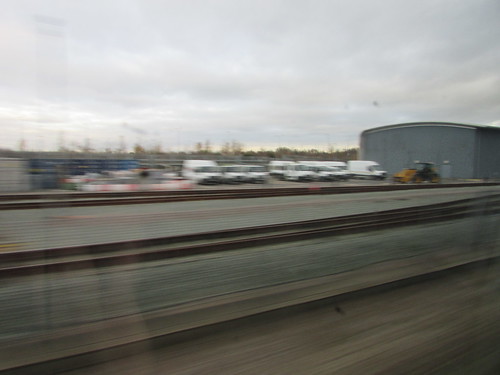
High Speed 1: Singlewell Maintenance Depot.
I'm afraid the combination of high speed and a very dull day made photography disappointing. I failed to capture perhaps the most interesting view, on the left of the train, as we crossed the River Medway where, looking downstream, the imposing bulk of Rochester Castle rose up on the right bank. Shortly after, we passed through North Downs Tunnel (just over 3 km long) and sped on towards Ashford. There were four short tunnels, the loops at Lenham and the 120m long Westwell Leacon Lane Tunnel. On our left, the third-rail electrified line from Maidstone ran parallel and I noted the Tarmac site at Hothfield with private sidings served by this line.
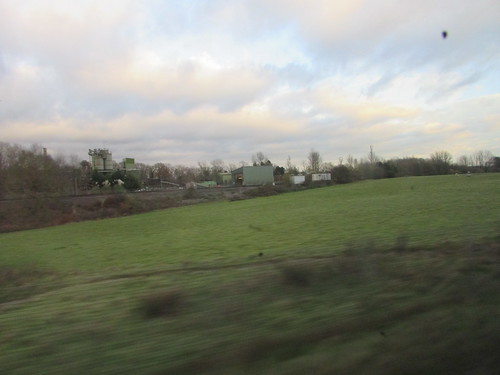
High Speed 1: Looking left from a Down train, the nearby conventional line from Maidstone East serves Tarmac's private sidings at Hothfield.
What is now called Ashford International station lies on the original South Eastern Railway (later the South Eastern and Chatham Railway) from London to Folkestone and Dover. To the west of the station, the line to Maidstone diverges northwards. To the east of the station, the line to Canterbury diverges northwards and the line to Hastings diverges southwards.
The new CTRL line by-passes Ashford International Station just to the north using the Ashford Viaduct. To cross both the Maidstone and Canterbury lines, CTRL passes under the Maidstone lines using Ashford Cut-and-cover Tunnel, then an incline connects to Ashford Viaduct which extends over the line to Canterbury.
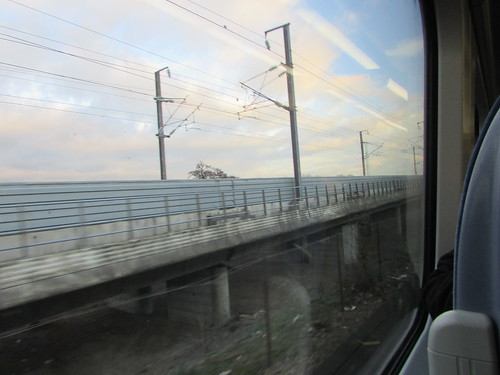
High Speed 1: View from Class 395 approaching Ashford International on the Down West Chord. Ashford Viaduct shown allows Channel Tunnel trains to bypass the station.
The rebuilt Ashford station derives its 'International' suffix from two new double-track chord lines - the West Chord leads from CTRL to the west end of Ashford International station, the East Chord leads from CTRL to the east end of Ashford International station.
My train from St. Pancras International used the Down West Chord to leave CTRL, pass under the Maidstone lines then cross over CTRL (still in the cut-and-cover tunnel) so as to enter platform 6 at Ashford International. Platforms 3,4,5 and 6 have both third rail 750 volt d.c. and overhead 25 kV a.c. electrification so my train arrived using overhead power and changed to third rail prior to leaving for Sandwich. South Eastern high speed trains towards London reverse this procedure, arriving using the third rail and changing to overhead in the platform, before joining CTRL using the Up West Chord. Flexibility is provided since Platforms 3,4,5 and 6 are signalled for movements in both directions.
Both the West Chord and East Chord lines are used by Eurostar trains calling at Ashford. International services can leave CTRL, stop at Ashford International and rejoin CTRL, remaining on 25 kV a.c. power throughout.
South Eastern High Speed trains (domestic) are confined to platforms 5 and 6 with platforms 3 and 4 reserved for Eurostar (international) services.
The weather was dull and cold and I had an appointment late afternoon so I only remained at Ashford long enough to take a few pictures of what remains of the older station. Then, I caught a South Eastern High Speed service from Platform 5 back to St. Pancras International.
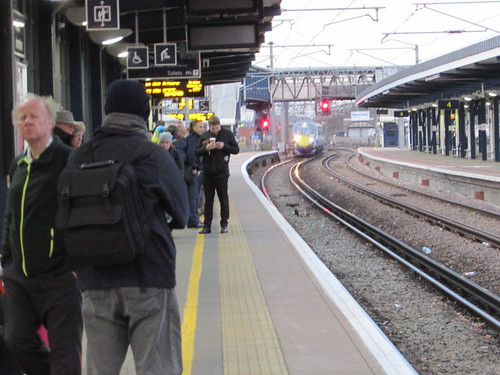
Ashford International: Class 395 approaching Platform 5 en route for St. Pancras International.
By Rail to the Continent
Early railways sought to promote cross-channel travel. Then (as now) new railways were authorised by an Act of Parliament. The South Eastern Railway (SER) obtained parliamentary approval for a line from London to Dover in 1836, but parliament mandated the sharing of existing lines at the London end, resulting in a roundabout route via Redhill. From Redhill, William Cubitt then provided the South Eastern Railway with an almost straight main line with reasonable gradients to Folkestone and Dover. Major intermediate stations (Redhill, Tonbridge, Paddock Wood, Headcorn, Ashford and Folkestone) were provided with through lines for fast trains and platform loops for stopping trains (Tonbridge, Ashford). Construction started in 1838 and the line was opened in 1843 to Folkestone, then Dover the following year.
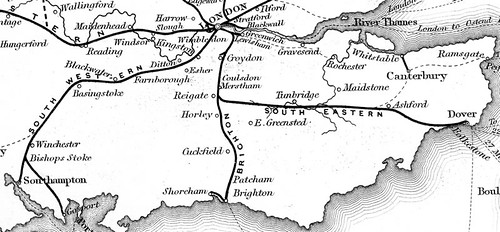
Railways in the South East of England in 1840 (from Whishaw).
The SER had a bad-tempered relationship with both its passengers and other railways, leading in 1853 to the East Kent Railway promoting a shorter line from London to Dover which would also serve important towns like Chatham and Rochester. The challenger railway had perpetual funding difficulties. It changed its name to the London Chatham and Dover Railway (LCDR) in 1859 and participated in the joint venture to build Victoria Station which opened in 1860. Somehow, both the SER and the LCDR struggled on until 1899 when they agreed to operate jointly as the South Eastern and Chatham Railway (SECR).
There's a little more about the SECR in the post Origins of the Southern Railway: Part 3 - S.E.C.R..
Ashford
As railways proliferated in the 19th century, Ashford became an important railway town. The SER built a new locomotive works at Ashford in 1847 which replaced the railway's original facility at New Cross. Following the joint operation agreement of 1899, work originally done at Longhedge by the LCDR was progressively transferred to Ashford. Following the Grouping in 1923, new building was concentrated at Eastleigh but Ashford locomotive works survived for repairs until 1962 and for wagon building until 1982. The picture below shows the extent of the works, situated to the east of the station on the south side of the main line to Dover, in 1929.
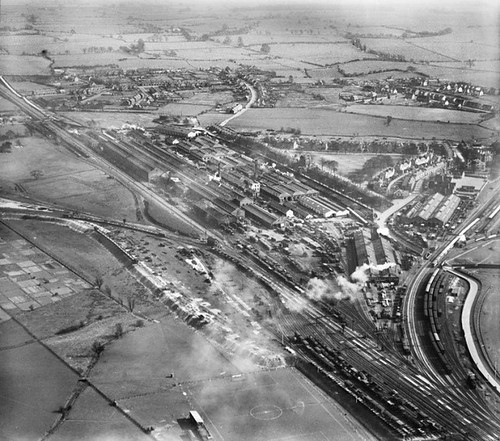
Ashford Railway Works 1929 (Photo: Kent History Forum).
Modern Railway Maps
Details of High Speed 1 and what remains of the S.E.C.R. today are shown in the 'Quail Track Diagrams':-
'Railway Track Diagrams Book 5: Southern and TfL' Third Edition, published by TRACKmaps (ISBN 978-0-9549866-4-3).
Related posts on other websites
Ashford Railway Works (Wikipedia).
Related posts on this website
Class 373 Test Train to Paris.
Class 395 Trainsets.
Testing Class 395 Trainsets.
Channel Tunnel Rail Link.
Origins of the Southern Railway: Part 3 - S.E.C.R.
My photograph albums
Where necessary, clicking on an image above will display an 'uncropped' view or, alternately, pictures may be selected, viewed or downloaded, in various sizes, from the albums listed:-
London: St. Pancras Station.
High Speed 1.
Ashford International.
